November 13, 2010
 - Folded up the TT320X-AG fits comfortably in a camera bag. Photo courtesy of AstroTrac.
Tracking celestial objects as they travel across the night sky using guided wide-field astrophotography usually requires you set up a heavy telescope mount, even if you just need to support a lightweight camera and lens. The 2.2-pound (1 kg) AstroTrac TT320X-AG is small enough at just 17x3x1.5 inches to be easily folded and tucked into a camera bag. This mount unfolds quickly and reliably, and can be mounted on a camera tripod, and then aligned with the celestial pole using the optional polar scope, to track celestial objects across the night sky precisely. The AstroTrac TT320X-AG is compatible with both the AstroTrac Polar Scope, Pier, Wedge, and Head products and allows you to take longer exposures at longer extended focal lengths, for bright images with less noise. AstroTrac indicates that the TT320X-AG only has a tracking error of about 5 arcseconds, peak-to-peak, over a period of 5 minutes, perfect for wide-field views.
 - The TT320X-AG looks great and works like a charm
The AstroTrac TT320X-AG uses 8 AA batteries to provide power for its systems, which provides about 10 hours of use, and AA batteries are pretty easy to pick up, so power usage shouldn't be a problem. The AstroTrac TT320X-AG also has a right ascension autoguiding feature that's compatible with popular brands of autoguiders, like SBIG SG-4, Orion Starshoot, LVI SmartGuider, and autoguiding software like Maxim DL and PhD, but you'll need to order an additional cable required separately, to use this feature.
http://www.astrotrac.com/
 - The autoguiding port is ready to start your "Journey to the Beginning of Space and Time"
Posted by Warren Wong. Posted In : telescope mounts
November 13, 2010
 - The Celestron CGE Pro German equatorial mount. Photo courtesy of Celestron.
Using a sturdy mount to keep your time-machine-to-the-stars stationary is the difference between spectacular moments during your journey to the beginning of the universe, and less than fabulous views due to poor performance on the part of your telescope. One of the top heavy-duty mounts for your time-machine-to-the-stars is the Celestron's CGE Pro German computerized equatorial mount. Light enough at 154 lbs to be transported to the perfect dark sky viewing spot, the Celestron CGE Pro German computerized equatorial mount can hold up to 90 pounds of telescope firmly in place, for timeless and unforgettable moments on your journey to the beginning of the universe. Just plug the Celestron CGE Pro into a 12-volt power source and the on-board polar-alignment routine quickly and reliably helps you align the mount, even if the celestial pole is hidden from view. Making locating and following the celestial object of your choice across the night sky as easy as initializing the Celestron CGE Pro's systems and blasting off into the night sky where no man has been before.
http://www.celestron.com/c3/category.php?CatID=16
 - German engineering just can't be beat and the Celestron CGE Pro is one of the best you can buy
Posted by Warren Wong. Posted In : telescope mounts
November 11, 2010
Journey to the Beginning of Space and Time in a Celestron EdgeHD Series Telescope
 - Your time-machine-to-the-stars is waiting for you. Photo courtesy of Celestron.
Space travellers looking to journey to the beginning of the universe need to travel to infinity and back using the best time-machine-to-the-stars they can find. Celestron's new Celestron EdgeHD Series Schmidt-Cassegrain telescopes are the perfect time-machine-to-the-stars for the young traveller looking to journey to the beginning of the unvierse, or the veteran space traveller wanting to try out a new spaceship to the stars. Celestron EdgeHD Series Schmidt Cassegrain telescopes are available in sizes ranging from 8 to 14 inches and have a built-in field flattener/coma corrector in the baffle tube that according to the designers and engineers at Celestron eliminates a lot of the unwanted star bloat that can plague photos taken with conventional SCTs. Add in the enhanced focuser that engineers designed for the Celestron EdgeHD Series telescopes to reduce the image shift problems users of SCTs have noted and your time-machine-to-the-stars is ready to blast-off.
http://www.celestron.com/c3/category.php?CatID=2
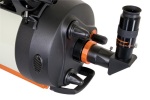 - Instrumentation to make the professional astronomer smile with glee
Posted by Warren Wong. Posted In : Schmidt-Cassegrain telescopes
November 11, 2010
Board Binoculars to Begin Your Journey to the Beginning of the Universe.
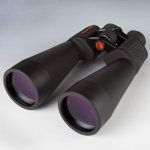 - One of the best astronomical observing binoculars you can get. Photograph courtesy of Zhumell.
Binoculars are a useful and fun way to view the solar system and delve even deeper into the cold darkness of space and time. The modern astronomer makes use of an amazing array of scientific viewing devices and techniques in the human journey to the beginning of the universe. Large telescopes on both the Earth and orbiting the planet search the cosmos on a daily basis, using advanced optical systems, and new techniques to look at the universe in ways never before experienced by humans. Thousands of amateur star-gazers also use similar optical systems and techniques based on the same equipment to view the universe on a nightly basis. Good viewing binoculars, however, are a great and fun way for casual star-gazers to journey to nearby celestial objects to have a quick look, and they're also a good way to tour the universe.
Why bother with binoculars considering the array of sophisticated viewing equipment available for the dedicated amateur astronomer? Binoculars have a few points in their favor that make them good for the casual star-gazer. Binoculars have a low power and wide field of view that makes them an ideal time-machine-to-the-stars for casual viewers of the night sky, or even sophisticated viewing of the universe. Science has certainly proven that viewing the night sky with two eyes is better than viewing the universe with one. The human eye's power of resolution and ability to detect faint objects in the night sky dramatically improves using two eyes, rather than the one required for viewing with the traditional telescope. In addition, color perception and contrast of the view humans observe using two eyes, rather than one, improves noticeably.
Need more proof? On a clear, moonless night, headout to your favorite deep sky viewing spot to conduct a little test of your own. Once you arrive, keep both eyes open, while covering one eye with your hand, and take a look at the night sky. Make a mental note of the faintest stars you see in the night sky. Now, take your hand away from the eye you have kept covered and view the same area of the night sky as before, and you'll see a lot more stars in the area you previously viewed. It isn't unusual for some star-gazers to experience as much as a 10-percent improvement in perception using two eyes, rather than one, and this can be just the difference that provides some viewers on a casual journey to the beginning of the universe with a life-changing experience.
http://www.zhumell.com/binoculars/astronomical/
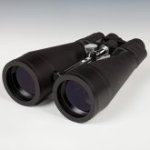 - Zhumell 20x80 SuperGiant Astronomical binoculars are great for casual viewing of the universe
Posted by Warren Wong. Posted In : astronomical binoculars
November 10, 2010
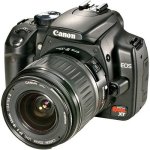 - The Canon EOS 350D introduced many astrophotographers to the wonders of digital imaging
Astroimaging records moments in space and time
Astroimaging is a great way to record the unforgettable moments of your journey to the beginning of the universe, photographing the night sky has never been easier for the amateur, and you can capture the memorable moments of your trip to show the grandchildren. The array of imaging equipment available today for the amateur astronomer looking for a suitable astroimaging camera to use as a time-machine-to-the-stars for never been more varied. We'll take you through the basics of cameras and their uses in astroimaging, starting with the modern camera, to help you decide just how you want to go about astroimaging and what kind of equipment you want to use to do the job.
The modern camera used for astroimaging uses electronic imaging sensors to help produce the images you'll take on your trip. Currently, there are two different types of electronic imaging sensors, CCD (charge-coupled device) and CMOS (complementary metal-oxide semiconductor), both essentially do the job the same way. Inside every modern camera tiny photocells, called pixels, and the circuitry to control the exposure time and read out the image are housed. The number of pixels needed for each view will vary from relatively small numbers for smaller images of planets or distinct celestial bodies, to millions of pixels (megapixel) for deep sky views of star fields.
Not all imaging sensors are designed and engineered equally, some imaging sensors produce color images, while others only create monochrome views of the universe. Modern color imaging sensors use a "Bayer" matrix, in which alternate pixels filter red, green and blue to produce the image, while a computer interpolates the data to smooth the image. Monochrome imaging sensors generally produce sharper images than color imaging sensors, but producing color images is more difficult, as you need to take red, green and blue exposures through separate filters and then use a computer to combine them to produce the color image.
Selecting the correct camera according to the astroimaging uses you have planned for your camera during your journey to the beginning of the universe is possibly the most important decision you can make in your desire to make sure the treasured memories of your trip to infinity and back are recorded for all time. You definitely want to make sure you're honest with yourself about what kind of astroimaging you want a camera for. Do you want to be able to take pictures of celestial objects in the day time sky? Can you use your astroimaging camera without having to connect it to a computer? The answers to these questions, and others, will help you determine the perfect astroimaging camera for "Journey to the Beginning of Space and Time".
http://www.canon.ca/inetCA/subCategoryHome?msegid=2&catid=17&scatid=129
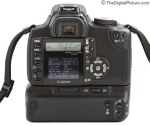 - The Digital Rebel XT came out early in 2005
Posted by Warren Wong. Posted In : astroimaging cameras
November 10, 2010
 - This telescope will change the way your child's view of the world around them and the universe. Photo courtesy of Celestron.
Open your child's eyes to the universe with a Celestron FirstScope
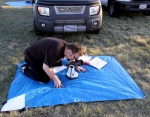 - Set up your FirstScope at your favorite dark sky spot and let your "Journey to the Beginning of Space and Time" begin
Take your child into the dark places of the Earth and spend the night staring upward at the night sky they probably didn't really know existed. This could be your opportunity to open up their mind to the real world and the possibilities of space and time, and turn interest into fascination. This is how astronomers are created and astronomers in the future will be game changers for the world and humanity. Celestron's FirstScope will light the fire of discovery in your child's mind and set them on a course that could lead to great moments in history. Only $49.95, Celestron's FirstScope is a 3-inch reflector with a standard 1 1/4 inch rack-and-pinion focuser, 20mm and 4mm eyepieces (which magnify 15x and 75x, respectively), and an amazing steady tabletop mount. Weighing just 4.5 pounds (2 kg), the FirstScope is light enough for your young ones to carry around safely, and sensitive enough to allow them to enjoy viewing the Moon, bright planets, and dozens of deep sky objects. The FirstScope also has the option of a separate accessory kit, which includes a finder scope, two eyepieces, a Moon filter and CD-ROM planetarium program, all for only $20.
Posted by Warren Wong. Posted In : reflector telescopes
November 10, 2010
 - A rising star on the horizon of usable and reliable eyepieces. Photos courtesy of Explore Scientific.
Explore the universe using a nitrogen-purged eyepiece
 - The 14mm, 9mm, and 20mm eyepieces
The right eyepiece for your time-machine-to-the-stars can make the difference between memorable views during your journey to the beginning of the universe, and less than perfect views due to the fact you don't have the equipment that to view the universe. Explore Scientific is a new kid on the eyepiece manufacturing block, but the 20mm eyepiece of their 100 Series of eyepieces is quickly gaining fame for producing timeless views of space and time. Similar in many ways to Explore Scientific's 9mm and 14mm offerings, the 20mm version of the 100 Series features enhanced optical coatings inside a barrel that has been purged with nitrogen and then sealed against the elements. A watertight barrel is a necessity when out in the wild as it will prevent fog from developing inside the barrel as the temperature goes down outside and consequently inside the barrel of the eyepiece. At the same time sealing the barrel against the elements keeps dust and fungus from contaminating the eyepiece and ruining your view of the universe.
Posted by Warren Wong. Posted In : telescope accessories
November 10, 2010
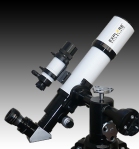 - One night exploring with time-machine-to-the-stars and you won't want to come home. Photo courtesy of Explore Scientific.
Take a journey backward in space and time to a moment distant beyond your imagination
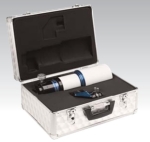 - One small and compact package
Explore Scientific is one of the new boys on the eyepiece manufacturing block, with both wide field eyepieces and several fine telescopes perfect for young and old amateur star gazers looking for a usable and reliable time-machine-to-the-stars for their journey to the beginning of the universe.
Explore Scientific's 3.15-inch (80mm) f/6 Triplet ED Apochromatic Refractor is built around a triple objective, features a 2-inch dual-speed Crayford focuser, a 8x50 correct-image finder scope, a 2-inch star diagonal with a 1 1/4-inch adapter, and a dovetail mounting plate for securing your time-machine-to-the-stars to many of the most popular alt-azimuth mounts being sold today. The perfect setup for your journey to the stars and one sure to provide you with endless views of space and time you'll never forget.
Posted by Warren Wong. Posted In : apochromatic refractors
November 9, 2010
 - A Bahtinov focusing-mask will save you time for other things
An essential focusing-tool for your journey to the beginning of the universe. Photos courtesy of Bahtinov.
 - Achieving perfect focus can be time-consuming and difficult without a focusing mask to help you
One of the toughest things to achieve when trying to take timeless pictures during your journey to the beginning of the universe will be getting a sharp focus on your time-machine-to-the-stars. Professional astronomers and amateur astronomers in-the-know will use a focusing-mask over the front of their time-machine-to-the-stars, rather than relying on trial and error to take pictures of unforgettable views during their trip to the stars. One of the best and easiest to use and setup face-masks on the market is the Bahtinov face-mask sold by Focus-Mask. Simply aim your time-machine-to-the-stars toward the star of your hearts desire, take a short 3 to 5 second exposure of your target, and then take a look at the three diffraction spikes on the Bahtinov face-mask. Adjust the focus on your time-machine-to-the-stars, take another 3 to 5 second exposure of your target, and once again examine the diffraction spikes. Continue this process until the middle diffraction spike lies directly between the other two spikes and you should be ready to take a shot of your hearts desire your kids will never forget.
Before you head out on the next leg of your journey to the beginning of the universe grab a Bahtinov face-mask, or another face-mask, and your view and astrophotography will improve significantly, and you'll have more time for timeless views, rather than spending time trying to focus your time-machine-to-the-stars.
Posted by Warren Wong. Posted In : telescope accessories
November 6, 2010
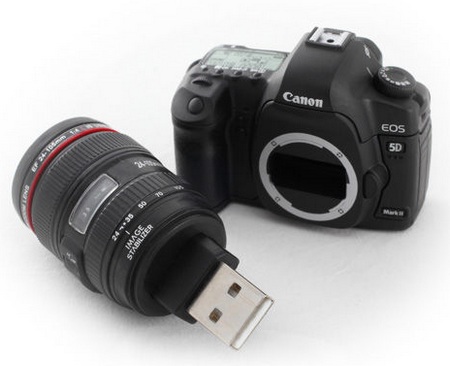 - The newest star gazers dream is ready for your "Journey to the Beginning of Space and Time"
With the Canon EOS 5D Mark II
Easy to use, an array of useful and reliable features, and an eye-catching 21 pixels of resolution makes the Canon EOS 5D Mark II a star gazers dream. Hidden within the Canon EOS 5D Mark II lies a 21.1-megapixel, full-frame complementary metal-oxide semiconductor (CMOS) sensor that captures celestial bodies in unforgettable high resolution images that will make your "Journey to the Beginning of Space and Time" the trip of your lifetime. This metal-oxide sensor allows star gazers to capture wider field of view than previous sensors due to its 35.9mm by 24mm size.
Designed to withstand the rigors of night time environments and possible collisions with the ground, or even a cement floor, the Canon EOS 5D Mark II saves large astroimages in seconds to a Compact Flash memory card. You can view your image on the 3.0-inch, 920,000 dot LCD view screen on the rear of the Canon EOS 5D Mark II in all lighting conditions. Designers and engineers even included the option to add a handy and time-saving Canon TC-80N3 remote control to your Canon EOS 5D Mark II, which allows you to set multiple images with certain exposure times and the time period between your exposures.
Posted by Warren Wong. Posted In : astroimaging cameras
|
Author
Warren Wong
Prince George, British Columbia
|


















